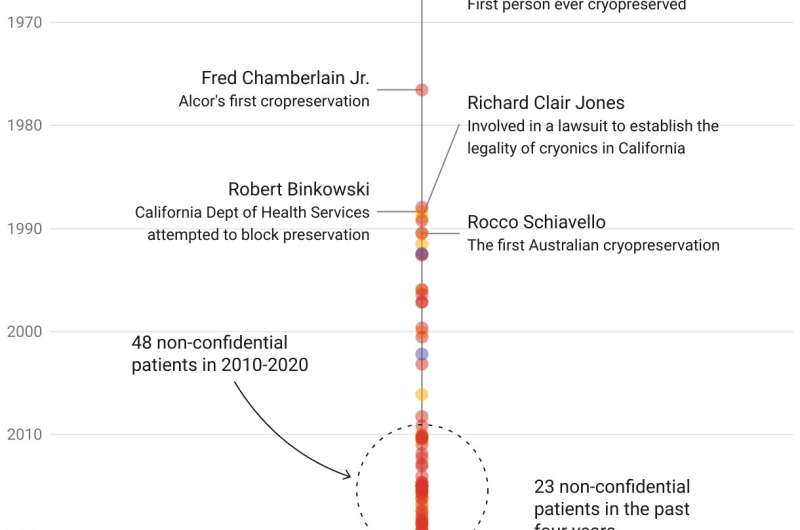This article has been reviewed according to Science X's editorial process and policies. Editors have highlighted the following attributes while ensuring the content's credibility:
fact-checked
trusted source
written by researcher(s)
proofread
You can now be frozen after death in Australia. If you're revived in the future, will you legally be the same person?

In recent weeks, Southern Cryonics—the southern hemisphere's only cryopreservation facility, located in rural New South Wales—announced it had successfully cryopreserved its first patient.
There are only a handful of cryopreservation facilities across the globe—two in the United States, and one each in Russia, China, Australia and Switzerland. If the claims made on their websites and in the press are accurate, these facilities likely have no more than 600 patients in cryonic storage in total.
Media reports however suggest interest in cryopreservation has risen since the onset of the COVID pandemic, and thousands of people around the world have signed up to be cryopreserved after their death.
So, what is cryopreservation and what are its legal ramifications?
What is cryopreservation?
Cryopreservation is the process of using extreme cold to preserve biological material (such as semen, blood and tissue samples) for an extended time. The first living thing to be cryopreserved was a fowl sperm in the 1940s; the first person was cryopreserved in 1967.
To cryopreserve a person, the most important step is a process called "vitrification." First, the blood is pumped out of the body. It is replaced with a chemical protectant designed to partially replace the water in the body's cells with a chemical mixture that prevents the formation of ice (not unlike the antifreeze found in car engines).
The body of the "patient" is then placed in something akin to a sleeping bag and sealed in a dewar—a large vat of liquid nitrogen—and maintained at a temperature of -196°C until the time for resurrection comes.
The ultimate aim is for the cryopreserved patient to be reanimated at a future time when medical science has advanced sufficiently to cure them of whatever caused their initial "death." However, there's no evidence to suggest it will ever happen in the future.

A possible legal minefield
While its proponents describe cryopreservation as "a second chance at life," scientists are quick to point out the chances of a successful reanimation are slim.
A person has to be declared legally dead before their body can be cryopreserved, meaning a successful reanimation would truly be a second (legal) life for the revived patient.
It could also be a legal minefield.
Questions that arise include:
- are you the same person in your second life as you were in your first, or are you a new legal person entirely?
- what happens to the legal obligations you undertook in your first life when you reawaken in your second?
- are you still bound by the phone contract you entered into?
- do you have to restart your mortgage repayments, and is your property even still your property?
The answer to the last question is likely to be "no." A dead person cannot own property so when they die, their estate—their money and material possessions—is distributed to others according to their will (or, if they die without a will in place, according to the rules of intestacy).
This means, short of radically rewriting our succession laws, if someone is successfully reanimated, none of the wealth or belongings they previously enjoyed will be available to them.
This creates the possibility of "cryonic refugees"—people who wake from cryopreservation in a future time with no social or community ties to rely on and no funds to live off.
In the US, one cryonics facility has attempted to get around this issue by encouraging patients to place their assets in long-term trusts.
A trust is a legal structure whereby Person A becomes the legal owner of a property, but can only use it for the benefit of Person B. There are particular rules about who Person B can be—they have to be legally identifiable, for example, and must be able to claim the trust property within a set time period (80 years in many Australian jurisdictions).
In the case of the cryonics trust, Person B is the reanimated patient—someone of uncertain legal identity (remember, we don't know if the reanimated patient is the same legal person across their two lives or not) with no guarantee of claiming the trust property within the necessary time period.
These are certainly reasons for lawyers to be skeptical. And of course, even if the trusts are upheld, there is no guarantee the assets they contain will retain their value in an unknown future world.
Other legal gray areas
Even prior to reanimation, however, a cryopreserved patient's finances can present legal difficulties.
While the upfront costs of the initial cryopreservation procedure—which can come in at more than A$150,000—are often covered by life insurance policies or a one-off payment in a will, the fact that cryonic storage is intended to last for the very long term raises questions about how ongoing bills will be paid far into the future.
There are even historic examples of cryonics facilities threatening to remove patients from suspension unless outstanding storage bills are paid.
Would such an action constitute murder? Can you kill someone who is already dead?
To reach an answer, the law will likely require a test case.
Provided by The Conversation
This article is republished from The Conversation under a Creative Commons license. Read the original article.![]()





















